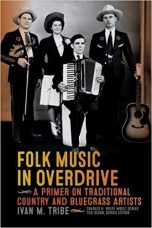By now (actually since the 1970s and thanks to a number of folk revivals) it is no secret that the geographical region of the Upland South was actually exploding with musical talent at the beginning of the 1920s. The states of Kentucky, Tennessee, Virginia and Carolina produced countless masters and some tuneful virtuosi.
 The artists from that region would play “their music,” which would be just the music they heard when they grew up as kids; that music would later be described as country music. However, originally, it was ‘one’ music or musical style typical to the region. Many of them today would be filed under country musicians, while back then the labels were hillbilly music or Old Time Music string bands.
The artists from that region would play “their music,” which would be just the music they heard when they grew up as kids; that music would later be described as country music. However, originally, it was ‘one’ music or musical style typical to the region. Many of them today would be filed under country musicians, while back then the labels were hillbilly music or Old Time Music string bands.
However, to be more exact, the musical style in focus here is – little wonder if we consider the region – country music, or rather a genre/sub genre very close to it, namely bluegrass. (Marketing in the early 1960s made this distinction, due to a famous article by folklorist Alan Lomax in Esquire magazine, where he was among the first researchers to have singled out the name “bluegrass” as a distinct form of country music.)
“What music listeners term bluegrass, according to connoisseurs of the style, originated in 1946 when Grand Ole Opry star Bill Monroe assembled …. [his band] … the Blue Grass Boys. … This form of acoustic string music attained considerable popularity, especially in the Appalachian South and Piedmont regions where string-band music had flourished for at least one generation and probably longer.”
For that reason, and as there are already numerous publications on the bluegrass superstars like Bill Monroe (who rightfully has to be credited the lion’s share for making the style popular) or the Stanley Brothers, essays on those musicians are missing in this publication.
Instead, this volume is dedicated to the artists in the background, whose names were only revealed to the collectors who would read the liner notes. The musicians who remained in their status as sidemen or concert openers, often excellent performers, but those who were denied stardom nonetheless.
It becomes obvious, after reading the altogether 39 portraits, that the post-WWII generation of musicians was in a way gifted like no other before them. Included are texts on Mac Odell, Carl Story, Joe Meadows, the Coon Creek Girls, Natchee the Indian and many others. (Almost all essays were published previously by the author in the genre’s leading periodical Bluegrass Unlimited and other journals and were revised for this publication.) As those musicians in particular have been largely neglected by researchers, producers and potential audiences, author and emeritus professor of history Ivan Tribe has devoted this volume to them and their stories.
The individual essays do not come in chronological order, but are organized in groups of musical configuration such as families and groups, brother duets, husband-wife duets, leaders and sidemen.
Many details, recording histories, studio marketing decisions and the countless anecdotes that helped in making a certain song a hit (and have others unsupported) are collected here by a well-known bluegrass insider.
Incredibly many sources, interviews and articles were consulted to let these artists get back into the spotlight one more time, while giving a detailed but brief report on the shows they played, the labels they recorded for, how they met their respective idols, producers or mentor and continued their way.
And in a way, the book covers the entire recording history of bluegrass, too.
This is a valuable addition to bluegrass and early country music research, as the protagonists here would probably never receive their own studies or biographies and otherwise, sooner or later, their names and stories would be entirely forgotten.
Review by Dr. A. Ebert © 2018
Ivan Tribe. Folk Music in Overdrive: A Primer on Traditional Country and Bluegrass Artists. (Charles K. Wolfe Music Series) University of Tennessee Press, 2018, 392 p.
